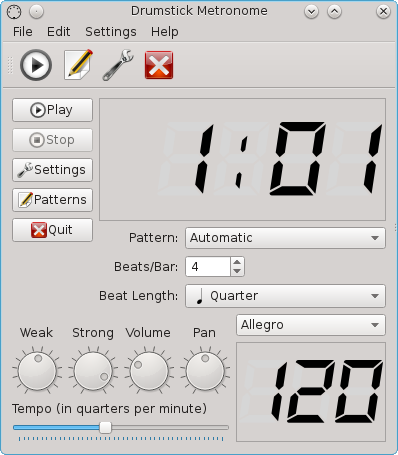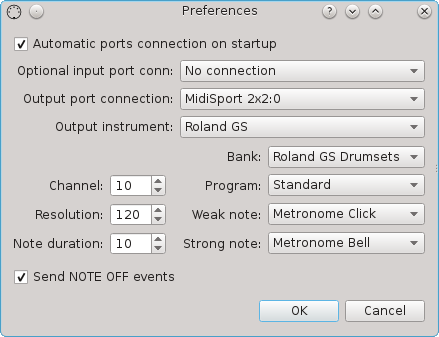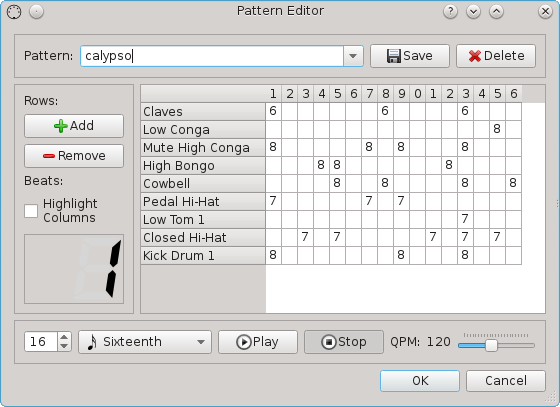

Introduction
Drumstick Metronome is a MIDI based metronome using the ALSA sequencer.
Intended for musicians and music students, it is a tool to keep the rhythm while playing musical instruments.
It uses MIDI for sound generation instead of digital audio, allowing low CPU usage and very accurate timing thanks to the ALSA sequencer.
Report problems, bugs and feature requests to the author or the tracking system at SourceForge project site
Copyright © 2005-2023, Pedro Lopez-Cabanillas <plcl at users.sourceforge.net>
Features
- Easy to use graphic user interface.
- MIDI only. Can be used with software- or external MIDI synthesizers.
- Based on ALSA sequencer. Provides input and output ports. Very accurate timing.
- Custom rhythm patterns.
- Highly customizable parameters.
- Built-in connection manager, can be used with external connection managers.
- External control: play/stop/continue commands, can be controlled using D-Bus or MIDI Realtime System messages.
- GPL licensed
Getting Started
This program uses the MIDI protocol, so it is a good idea to to have some basic notions about MIDI in order to fully understand the concepts behind it. You can find here a good introduction about what is midi.
Drumstick Metronome produces MIDI events. If you want to hear the events translated into sounds you need to connect the MIDI OUT port from this program to the MIDI IN port of a MIDI synthesizer. It can be either a hardware MIDI synthesizer or a software one. If it is an external hardware synthesizer, you also need an ALSA supported MIDI interface installed in your computer, and a MIDI cable attached to both the computer's MIDI interface, and the synthesizer MIDI IN socket.
If you don't have an external MIDI synthesizer, you can still use the program with a MIDI software synthesizer supporting ALSA sequencer connections, like QSynth. Start your software synthesizer before Drumstick Metronome, and then make the connection between the two programs, either on Drumstick Metronome's “Configuration” dialog or using an external connection manager like QJackCtl. here you can see an image of the three programs working together.
Don't forget to install a good Sound Font into QSynth's "Setup..." dialog.

You can find more information in the Drumstick Metronome Handbook. Use the F1 key, or the Help menu to access the document at any time while you are using the program. It is also available online.
Concepts
Main Window
- Pattern: either "Automatic" or a custom pattern definition
- Beats/Bar: it is the first component of the Time signature. Indicates the number of ticks corresponding to a rhythm pattern.
- Beat length: it is the second component of the Time signature. Indicates the length of each beat, being 1=whole, 2=half, 4=quarter or crotchet, and so on.
- Weak/Strong note velocity: MIDI Note velocity is a value from 0 to 127 indicating with how much force the note should be played.
- Volume: MIDI Volume level is a value from 0 to 127 indicating the volume level for the output MIDI channel.
- Pan: MIDI Pan is a value from 0 to 127 indicating the device's stereo position when the synth device has stereo audio outputs. 64 is the center.
- Tempo: speed of the music, expressed in quarters by minute (Mälzel Metronome units).
Configuration dialog (Settings)
- Automatic ports connection on startup. If checked, the chosen input and output ports selected below are remembered for the next program run.
- Output port connection. The ALSA Sequencer port where the metronome MIDI events are sent.
- Optional Input port conn. The ALSA Sequencer port from which MIDI transport events can be read.
- Channel: The MIDI channel for outgoing MIDI events.
- Program: The MIDI Program number that is sent to the output port right after the "Play" button is pressed.
- Resolution: The number of parts, or divisions of a single beat. Typically a number divisible by both 3 and 4.
- Weak note: MIDI Note number to signal a weak beat of the automatic pattern.
- Strong note: MIDI Note number to signal the first beat of the automatic pattern.
- Send NOTE OFF events: percussion sounds usually don't need Note Off events to be sent after every Note On. Uncheck only if your synthesizer/instrument supports this setting.
- Note duration: The length of the time span between a "Note On" and its corresponding "Note Off" event.
Downloads
Source packages are available here.
Requirements
In order to successfully use Drumstick Metronome, you need Qt5, Drumstick, ALSA drivers and ALSA library.
ALSA library, drivers and utilities can be found at ALSA home page.
This page was modified on (none)

